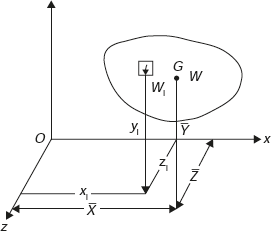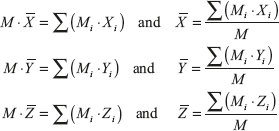In Figure 11.1, an irregular shape is shown for which we want to calculate the centre of gravity, centre of mass, and centroid. Here, our purpose is to differentiate the concepts of these three different terms. It is assumed that the irregular shape, as shown in Figure 11.1, is of uniform thickness, density, and subjected to uniform gravitational field.

Figure 11.1 Centre of Gravity, Centre of Mass, and Centroid
Let Wi be the weight of an element in the given body. W be the total weight of the body. Let the coordinates of the element be Xi, Yi, Zi and that of centroid G be ![]() ,
, ![]() , and
, and ![]() . Since W is the resultant of Wi forces. Therefore,
. Since W is the resultant of Wi forces. Therefore,

Here, ![]() ,
, ![]() , and
, and ![]() are coordinates of centre of gravity, G. The resultant gravitational force acts through the point G.
are coordinates of centre of gravity, G. The resultant gravitational force acts through the point G.
If gravitational field be uniform, the gravitational acceleration (g) will be same for all the points. Therefore, in of Wi, we can put Mig and the centre of mass can be expressed as

Here, ![]() ,
, ![]() , and
, and ![]() are coordinates of centre of mass, G. The resultant mass of the body is concentrated at the point, G.
are coordinates of centre of mass, G. The resultant mass of the body is concentrated at the point, G.
If the density of mass (γ) and the thickness of the body (t) is uniform, the mass Mi can be represented as γ × Ai × t. The centroid can be expressed as

Here, ![]() ,
, ![]() ,
, ![]() and are coordinates of centroid, G.
and are coordinates of centroid, G.
11.2.2 Centroid of I-section
The I-section, shown in Figure 11.2, can be divided into three parts—lower part of area A1, middle part of area A2, and upper part of area A3. The lengths and widths of all the parts of I-section are shown in Figure 11.2. Let the X and Y coordinates pass through origin O as shown in Figure 11.3.

Figure 11.2 Centroid of I-section

Figure 11.3 Reference Axes for I-section
The coordinates for centroid can be calculated using the following formula:

In the case of axial symmetry about Y-axis (i.e., y-axis passes through centres of sections 1, 2 and 3), the distances of X1/2, X2/2, X3/2 from origin will be zero.
Hence, ![]() = 0.
= 0.
Leave a Reply